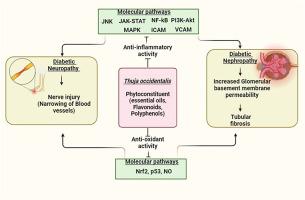Unlocking the mechanistic potential of Thuja occidentalis for managing diabetic neuropathy and nephropathy
IF 3.3
3区 医学
Q1 INTEGRATIVE & COMPLEMENTARY MEDICINE
Journal of Traditional and Complementary Medicine
Pub Date : 2024-04-24
DOI:10.1016/j.jtcme.2024.04.009
引用次数: 0
Abstract
Diabetes mellitus and its debilitating microvascular complications, including diabetic neuropathy and nephropathy, represent a growing global health burden. Despite advances in conventional therapies, their suboptimal efficacy and adverse effects necessitate exploring complementary and alternative medicine approaches. Thuja occidentalis, a coniferous tree species native to eastern North America, has gained significant attention for its potential therapeutic applications in various disorders, attributed to its rich phytochemical composition. The present comprehensive review evaluates the therapeutic potential of Thuja occidentalis in managing diabetic neuropathy and nephropathy, with a particular emphasis on elucidating the underlying cellular and molecular mechanisms. The review delves into the active constituents of Thuja occidentalis, such as essential oils, flavonoids, tannins, and proanthocyanidin compounds, which have demonstrated antioxidant, anti-inflammatory, and other beneficial properties in preclinical studies. Importantly, the review provides an in-depth analysis of the intricate signaling pathways modulated by Thuja occidentalis, including NF-κB, PI3K-Akt, JAK-STAT, JNK, MAPK/ERK, and Nrf2 cascades. These pathways are intricately linked to oxidative stress, inflammation, and apoptosis processes, which play pivotal roles in the pathogenesis of diabetic neuropathy and nephropathy. Furthermore, the review critically evaluates the evidence-based toxicological data of Thuja occidentalis as a more effective and comprehensive therapeutic strategy in diabetes complications. Therefore, the current review aims to provide a comprehensive understanding of the therapeutic potential of Thuja occidentalis as an adjunctive treatment strategy for diabetic neuropathy and nephropathy while highlighting the need for further research to optimize its clinical translation.

挖掘西洋杉治疗糖尿病神经病变和肾病的机制潜力
糖尿病及其使人衰弱的微血管并发症,包括糖尿病神经病变和肾病,是全球日益沉重的健康负担。尽管传统疗法取得了进步,但由于其疗效不佳和不良反应,有必要探索补充和替代医学方法。西洋杉(Thuja occidentalis)是一种针叶树种,原产于北美东部,因其丰富的植物化学成分而在各种疾病的潜在治疗应用中获得了极大的关注。本综述评估了西洋杉在控制糖尿病神经病变和肾病方面的治疗潜力,尤其侧重于阐明其潜在的细胞和分子机制。综述深入探讨了侧柏的活性成分,如精油、类黄酮、单宁和原花青素化合物,这些成分在临床前研究中表现出抗氧化、抗炎和其他有益特性。重要的是,这篇综述深入分析了西洋接骨木调节的复杂信号通路,包括 NF-κB、PI3K-Akt、JAK-STAT、JNK、MAPK/ERK 和 Nrf2 级联。这些通路与氧化应激、炎症和细胞凋亡过程密切相关,在糖尿病神经病变和肾病的发病机制中起着关键作用。此外,本综述还对基于证据的毒理学数据进行了批判性评估,认为侧柏叶是一种更有效、更全面的糖尿病并发症治疗策略。因此,本综述旨在全面了解刺五加作为糖尿病神经病变和肾病的辅助治疗策略的治疗潜力,同时强调进一步研究的必要性,以优化其临床转化。
本文章由计算机程序翻译,如有差异,请以英文原文为准。
求助全文
约1分钟内获得全文
求助全文
来源期刊

Journal of Traditional and Complementary Medicine
Medicine-Complementary and Alternative Medicine
CiteScore
9.30
自引率
6.70%
发文量
78
审稿时长
66 days
期刊介绍:
eJTCM is committed to publish research providing the biological and clinical grounds for using Traditional and Complementary Medical treatments as well as studies that demonstrate the pathophysiological and molecular/biochemical bases supporting the effectiveness of such treatments. Review articles are by invitation only.
eJTCM is receiving an increasing amount of submission, and we need to adopt more stringent criteria to select the articles that can be considered for peer review. Note that eJTCM is striving to increase the quality and medical relevance of the publications.
 求助内容:
求助内容: 应助结果提醒方式:
应助结果提醒方式:


